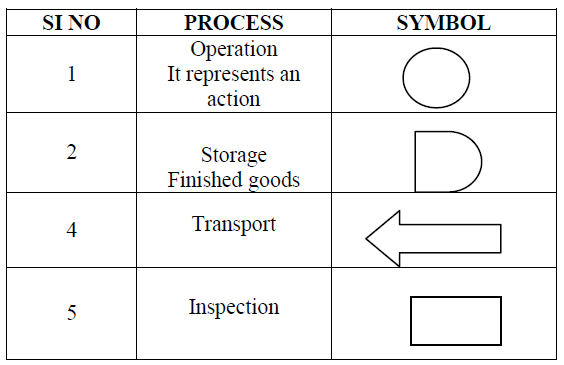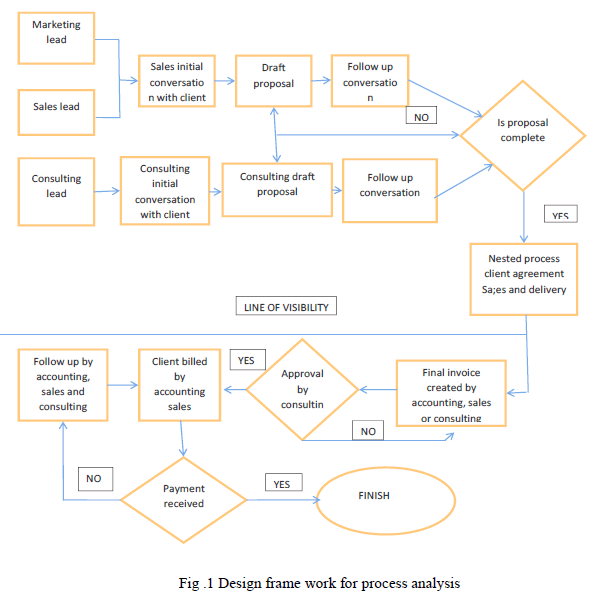ISSN ONLINE(2319-8753)PRINT(2347-6710)
ISSN ONLINE(2319-8753)PRINT(2347-6710)
Ashwini1, Amardeep2
|
| Related article at Pubmed, Scholar Google |
Visit for more related articles at International Journal of Innovative Research in Science, Engineering and Technology
Business process is one of the most popular topic in the organization and management Organizations have realized that the first step in achieving business success is to analyse and define their business processes. A business process is a set of related business activities that combine to deliver something of value to a customer or to the organization .The goal of the analysis phase of a business process design effort is to understand how the processes of an organization or department function and interact, the goal of the design phase is to improve the way that those processes function and interact.
Keywords |
| Process analysis, organization design |
INTRODUCTION |
| Process analysis is the documentation and detailed understanding of how work is performed and how it can be redesigned. The method is based on the general system theory and functional approach. It means that organization’s performance is discussed as a system of functions and business processes are discussed in relationship with organization’s functions. An outcome of using the method is a system of procedural rules, which is a graphic-verbal model of organization’s performance In business, System Analysis and Design refers to the process of examining a business situation with the intent of improving it through better procedures and methods. System analysis and design relates to shaping organizations, improving performance and achieving objectives for profitability and growth. Organizations are complex systems that consist of interrelated and interlocking subsystems. Changes in one part of the system have both anticipated and unanticipated consequences in other parts of the system. The systems approval is a way of thinking about the analysis and design of computer based applications. It provides a framework for visualizing the organizational and environmental factors that operate on a system. |
METHODOLOGY |
| There is always a systemic approach towards process analysis. It consists of a suggestion team where by which employees submit their ideas towards improvement. Team which work at one or more steps in the process, do the process analysis and make necessary improvements. A diagram that traces the flow of information, customers, equipment, or materials through the various steps of a process. Having identified the customer Driven objectives, the mission or vision statement is formulated. The vision is what a company believes it wants to achieve when it is done, and a well-defined vision will sustain a company’s resolve through the stress of the reengineering process. It can act as the flag around which to rally the troops when the morale begins to sag and it provides the yard stick for measuring the company’s progress. |
| A. UNIT OF ANALYSIS |
| The definition of the process being analysed has direct implications for who needs to be interviewed by the research team. If the process crosses organizational boundaries (either multiple departments in the same, or multiple organizations), then it became important to collect data from individuals in each relevant organizational unit To accomplish data collection under these circumstances can be very difficult because organizations are sometimes quite reluctant to allow detailed scrutiny from individuals who are perceived to represent the interests of another organization. |
| Although it may not always be possible to fully verify process descriptions under these circumstances, it is important to get at least some descriptive information concerning all the major activities in a process. |
| B. PROCESS CHARTS |
| An organized way of documenting, the activities performed by a person or group of People at a work station, with a customer, or on Materials. Five categories of process charts: |
| Operations that change create or add something. |
| Transportation (materials handling): Moving something |
| Inspection: Checking or verifying something. |
| Delays: Time spent awaiting further action. |
| Storage: When something is put away until a later time |
 |
| C. EVALUATING PERFORMANCE |
| Checklist: A form used to record the frequency of occurrence of certain service or product characteristics related to performance. |
| Histogram: A summarization of data measured on a continuous scale, showing the frequency distribution of some quality characteristic (the central tendency and dispersion of the data). |
| Bar chart: A series of bars representing the frequency of occurrence of data characteristics measured on a yesor- no basis. |
| Pareto Chart: A bar chart on which factors are plotted in decreasing order of frequency along the horizontal axis. |
| The design frame work for process analysis for any organization shown in below figure |
 |
CONCLUSION |
| This paper reviews that the framework for process analysis by designing the business process to satisfy the customer requirements in the market. System analysis and design relates to shaping organizations, improving performance and achieving objectives for profitability and growth. Analysis phase of a business process design effort is to understand how the processes of an organization or department function and interact, the goal of the design phase is to improve the way that those processes function and interact. |
References |
|